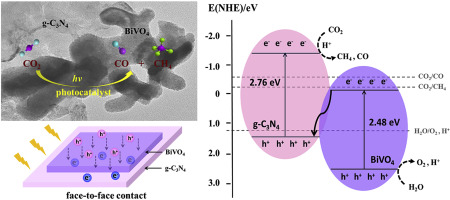Our official English website, www.x-mol.net, welcomes your feedback! (Note: you will need to create a separate account there.)
Remarkable photocatalytic activity enhancement of CO2 conversion over 2D/2D g-C3N4/BiVO4 Z-scheme heterojunction promoted by efficient interfacial charge transfer
Carbon ( IF 10.9 ) Pub Date : 2020-04-01 , DOI: 10.1016/j.carbon.2020.01.038 Mengfei Lu , Qiaoqiao Li , Chengliang Zhang , Xiaoxing Fan , Lei Li , Yuming Dong , Guoqing Chen , Haifeng Shi
Carbon ( IF 10.9 ) Pub Date : 2020-04-01 , DOI: 10.1016/j.carbon.2020.01.038 Mengfei Lu , Qiaoqiao Li , Chengliang Zhang , Xiaoxing Fan , Lei Li , Yuming Dong , Guoqing Chen , Haifeng Shi

|
Abstract In this study, a series of dual two-dimensional (2D/2D) Z-scheme g-C3N4/BiVO4 ultrathin nanosheets were successfully fabricated by coupling 2D g-C3N4 and 2D BiVO4 ultrathin nanosheets via a thermal-polymerization and subsequent hydrothermal method. The mass ratio between g-C3N4 and BiVO4 was optimized to improve the visible-light photocatalytic performance of CO2 reduction. Significantly, g-C3N4/BiVO4 (5:5) composite exhibited the optimal CO2 conversion efficiency towards CH4 (4.57 μmol g−1 h−1) and CO (5.19 μmol g−1 h−1), which were 4.8 and 4.4 folds higher than that of g-C3N4. The suitable band structures of single components induced the formed direct Z-scheme heterojunction, which efficiently suppressed the photoinduced carrier recombination and remained the strong redox capability. Moreover, the tight face-to-face interfacial contact between 2D g-C3N4 and 2D BiVO4 increased the transmission channels and accessible area for charges, and thereby facilitated charge transfer and provided abundant active sites for the photocatalytic reaction. Based on the trapping experiments, the photocatalytic mechanisms of g-C3N4/BiVO4 were reasonably proposed and validated by the photoluminescence spectra associated with time-resolved fluorescence decay. Furthermore, the repetitive photocatalytic experiments demonstrated the advantage of recyclability, which endowed 2D/2D Z-scheme g-C3N4/BiVO4 heterojunctions a promising application prospect.
中文翻译:

高效界面电荷转移促进了二维/二维 g-C3N4/BiVO4 Z 型异质结上 CO2 转化的显着光催化活性增强
摘要 在本研究中,通过热聚合和随后的水热法将二维 g-C3N4 和二维 BiVO4 超薄纳米片耦合,成功制备了一系列双二维 (2D/2D) Z 型 g-C3N4/BiVO4 超薄纳米片。 . 优化 g-C3N4 和 BiVO4 之间的质量比以提高可见光光催化 CO2 还原性能。值得注意的是,g-C3N4/BiVO4 (5:5) 复合材料对 CH4 (4.57 μmol g-1 h-1) 和 CO (5.19 μmol g-1 h-1) 表现出最佳的 CO2 转化效率,分别是 4.8 和 4.4 倍高于 g-C3N4。合适的单组分能带结构诱导形成直接Z型异质结,有效抑制光诱导载流子复合并保持较强的氧化还原能力。而且,二维 g-C3N4 和二维 BiVO4 之间紧密的面对面接触增加了电荷的传输通道和可及面积,从而促进了电荷转移并为光催化反应提供了丰富的活性位点。在捕获实验的基础上,通过与时间分辨荧光衰减相关的光致发光光谱合理地提出并验证了 g-C3N4/BiVO4 的光催化机理。此外,重复的光催化实验证明了可回收性的优势,这使得二维/二维 Z 型 g-C3N4/BiVO4 异质结具有广阔的应用前景。在捕获实验的基础上,通过与时间分辨荧光衰减相关的光致发光光谱合理地提出并验证了 g-C3N4/BiVO4 的光催化机理。此外,重复的光催化实验证明了可回收性的优势,这使得二维/二维 Z 型 g-C3N4/BiVO4 异质结具有广阔的应用前景。在捕获实验的基础上,通过与时间分辨荧光衰减相关的光致发光光谱合理地提出并验证了 g-C3N4/BiVO4 的光催化机理。此外,重复的光催化实验证明了可回收性的优势,这使得二维/二维 Z 型 g-C3N4/BiVO4 异质结具有广阔的应用前景。
更新日期:2020-04-01
中文翻译:

高效界面电荷转移促进了二维/二维 g-C3N4/BiVO4 Z 型异质结上 CO2 转化的显着光催化活性增强
摘要 在本研究中,通过热聚合和随后的水热法将二维 g-C3N4 和二维 BiVO4 超薄纳米片耦合,成功制备了一系列双二维 (2D/2D) Z 型 g-C3N4/BiVO4 超薄纳米片。 . 优化 g-C3N4 和 BiVO4 之间的质量比以提高可见光光催化 CO2 还原性能。值得注意的是,g-C3N4/BiVO4 (5:5) 复合材料对 CH4 (4.57 μmol g-1 h-1) 和 CO (5.19 μmol g-1 h-1) 表现出最佳的 CO2 转化效率,分别是 4.8 和 4.4 倍高于 g-C3N4。合适的单组分能带结构诱导形成直接Z型异质结,有效抑制光诱导载流子复合并保持较强的氧化还原能力。而且,二维 g-C3N4 和二维 BiVO4 之间紧密的面对面接触增加了电荷的传输通道和可及面积,从而促进了电荷转移并为光催化反应提供了丰富的活性位点。在捕获实验的基础上,通过与时间分辨荧光衰减相关的光致发光光谱合理地提出并验证了 g-C3N4/BiVO4 的光催化机理。此外,重复的光催化实验证明了可回收性的优势,这使得二维/二维 Z 型 g-C3N4/BiVO4 异质结具有广阔的应用前景。在捕获实验的基础上,通过与时间分辨荧光衰减相关的光致发光光谱合理地提出并验证了 g-C3N4/BiVO4 的光催化机理。此外,重复的光催化实验证明了可回收性的优势,这使得二维/二维 Z 型 g-C3N4/BiVO4 异质结具有广阔的应用前景。在捕获实验的基础上,通过与时间分辨荧光衰减相关的光致发光光谱合理地提出并验证了 g-C3N4/BiVO4 的光催化机理。此外,重复的光催化实验证明了可回收性的优势,这使得二维/二维 Z 型 g-C3N4/BiVO4 异质结具有广阔的应用前景。


























 京公网安备 11010802027423号
京公网安备 11010802027423号